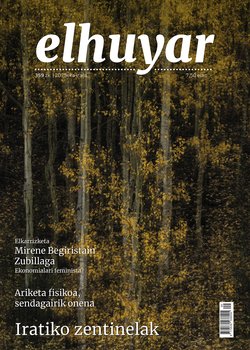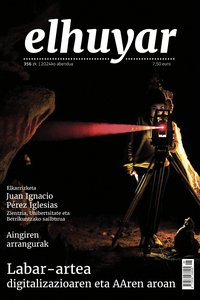Yeast for the wine of Rioja Alavesa
October is not like any other month in Arabar Rioja. It's vintage time. The works in the vineyards are about to end and in the wineries, on the other hand, the movement is about to begin. The winemaker of Bodegas Baigoro, Simon Arina, sees the vineyards and decides when the grapes are ripe and, consequently, ready to be harvested. This year the grape has ripened late.
In this winery the grapes are classified according to their quality. The color of the label will be decided by the laboratory: green, blue, red or golden. Each color represents a category. The raw material passes through the selection tables. Bunches of grapes in poor condition are discarded and the winemaking process begins.
The first step is to fill in the deposits. Thanks to alcoholic fermentation, the must will turn into wine in these giant barrels. This is a naturally fluctuating process. It will vary depending on the temperature and the microorganisms involved.
Assisted by Simón Arina. Oenologist; Bodega Baiger: "You have to think of it as something free. If it is very hot, the fermentation can be done in four days, while with a lot of cold it can be difficult to start and a month can pass."
However, in wineries that perform industrial production, the fermentation process is controlled. Yeast is added to the wort. The added yeasts will guide the fermentation and this year, for the first time, the wineries of Rioja Arabar will use local yeast.
The Tempranillo grape variety from the vineyards of Rioja Arabar was the starting point of the work. The yeasts live on the surface of the grape. Taking samples of grapes from the vineyards of Álava was therefore the first step. The microorganisms were characterized in the laboratory of the company Guserbiot, in which indigenous yeast has been isolated and produced.
Assisted by Miren Zumarraga; Guserbiot: "In most wineries around the world, commercial yeasts are used to finish the fermentation. And it happens that in most wineries they use external yeasts and not native ones. For example, French or Australian; and the same are used all over the world. The yeasts present in the local vineyards are the ones that best adapt to both the climatic condition, the conditions of the grape and the mosto. Our experience told us that it is the microorganisms found in nature that are best suited to these biological processes."
That is why they decided to isolate and produce an indigenous yeast for the production of Rioja Arabar wines.
It has taken six to be able to market indigenous yeast.
By Francisca Barbero; by Guserbiot: "Screening has been very laborious because we wanted to look for a large number of samples. The greater the variability, the more significant results. It was a hard job.”
The research project studied 600 yeasts. Certain behaviors were required of the yeast. working with large quantities of yeast allowed the exclusion of those exhibiting inappropriate behavior. For this, the winemaking process is recreated in the laboratory.
Proper fermentation is the first requirement required of the yeast.
Assisted by Miren Zumarraga; Guserbiot: "To work well technologically, to carry out the alcoholic fermentation well, to finish well."
That is, the yeast was required to prevail over the other microorganisms that could be present in the grape, to conduct fermentation and to deplete all sugars.
By Francisca Barbero; by Guserbiot: "Fermentation allows the sugar to be converted to ethanol and CO2. As a result, we should not have sugar at the end of the process. Yeast must be able to consume all the sugar and convert it into ethanol and CO2. And then add a few things in terms of flavor and taste."
Incubators are used in the laboratory to speed up the vinification process.
During the conversion of the must into wine, the yeasts add secondary aromas to the drink. The secondary aromas of wine are therefore the contribution of yeasts. This was an important point in the yeast selection process.
Assisted by Miren Zumarraga; Guserbiot:"What the oenologists wanted was to maintain or strengthen the local varietal aromas, the characteristics of the raw material."
By Francis Barbero; Guserbiot: "The Tenpranillo grape has a fruity touch. We went for it, we wanted the yeast to express that fruity touch as well."
Both the tasting tests and the analysis carried out in the laboratory itself can recognize the aromas that the yeast brings.
The selected yeasts were isolated in the laboratory and tested in cellars. Four yeasts were tested at the winery. But not everyone passed the test.
Assisted by Miren Zumarraga; Guserbiot: "We have found other yeasts that were very interesting, but in the end it has to meet many factors. Many of them didn’t behave well in the cellar and we rejected them.”
The production phase was also a turning point. Not all the yeasts studied were capable of industrial production.
Assisted by Miren Zumarraga; Guserbiot: "It is a very difficult phase in the production process and not all yeasts are able to meet this process. In the production phase there is a phase of drying that is very drastic, or it can be very hard for the yeast and not all of them endure."
Worldwide, the production of yeast is in the hands of large multinationals. That is why Guserbiot prefers not to provide production data. The commercialized yeast reflects the fruit and this was the desire and purpose of the wineries.
Assisted by Simon Arina. Oenologist; Bodega Baiger: "People want wines where the fruit is exposed. In wines seasoned in the barrel you also look for fruit and this is what we ask of yeast. We bet on that. Using the same yeast, the wines made in Argentina and Australia express the same aromas. It's horrible to realize that. Based on the natural microbial flora that we have in Rioja Arabar, ours is a bet for different wines."
Buletina
Bidali zure helbide elektronikoa eta jaso asteroko buletina zure sarrera-ontzian











